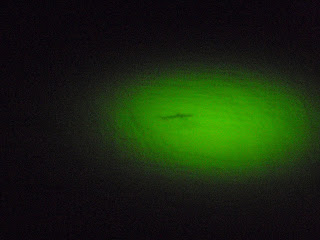"Click" it to enlarge it. It's rare for a photo to capture the true blue of a red's tail. I almost never get it, but I got it above. Answer: Chromatophores, specialized cells actually generate the color.
And, here's Archosargus probatocephalus, my nemesis for a number of years, locally. I called them "The Poor Man's Permit" in a story I wrote for Fly Fishing in Saltwaters back in 1997. Now I catch them with flies all the time. Watch out for their human-like teeth--CHOMP!! Double "click" this photo, and you can see that it's hard to tell this fish's smile from Jimmy Carter's toothy rictus. Thank God, this fish didn't lecture me.
And for Heaven's sake, look out for her dorsal spines! No venom here, but they're sharp!:
No adult bull sharks showed up this morning to chase my catch. We were all thankfull, though I haven't lost a fish I've caught to "secodary predation" to one in many a year--that I know about, that is. The bulls I've observed have no qualms about making a big ruckuss, a big to-do commotion of pandemonium, when they make a kill in two feet of water: FLOOOM! BAM! SPLASH! CARNAGE! OH, LOOK AT ME! D-R-A-M-A!!!
They sure are drama queens! I hope they don't mind my mocking their behavior. But they DO make a big show of it, really. I've got a few photos of the aftermath--foaming water at a distance, mostly. Some damned close and really out of focus, too. I hope you understand. I'll spare you the drama.





